Lure Fishing For Steelhead: Guide Tricks And Tactics
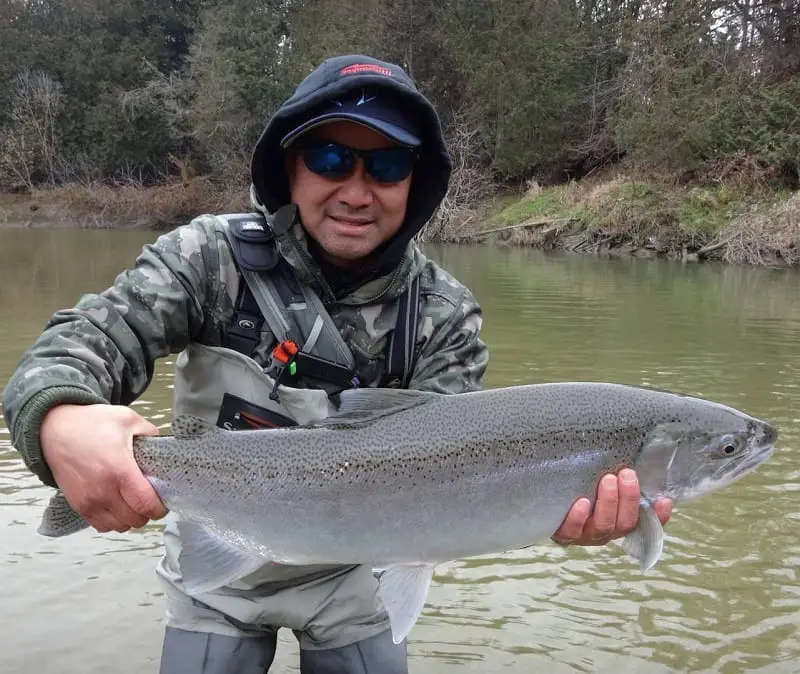
I’ve been fishing for steelhead with lures for almost forty years. I still remember my first time going down to the river to cast Shad-Rap type lures in the pools below the spawning steelhead and catching a few big steelheads.
I still remember the hard hits, and I still remember seeing some big steelhead chase my lure across the pool, only to turn away at the bank at the last second. It was very exciting.
Today, I guide for steelhead and my skills are much more refined. I know much more about steelhead and how to present a lure to get more of them to bite. I even have tactics to get more of those followers to commit to biting. I now teach other anglers how to lure fish for steelhead.
Fishing for steelhead with lures is a very effective and exciting way to catch steelhead in a river. Basic lure fishing for steelhead is easy to learn and doesn’t require much gear. For most guys, it’s cast, retrieve, and hope for a bite.
But, if you want to catch more steelhead than you are now, using the same guide tactics that I use can significantly increase the amount of steelhead you will catch.
Note: You are reading the new revised article which is shorter and to the point. If you want more details and the full (longer) article, check out How To Fish For Steelhead With Lures.
Use The Right Lures When Lure Fishing For Steelhead
Every lure has a different profile, different action, and a different sound. I choose lures based on the conditions. I have found that there are five different types of lures that continue to be effective.
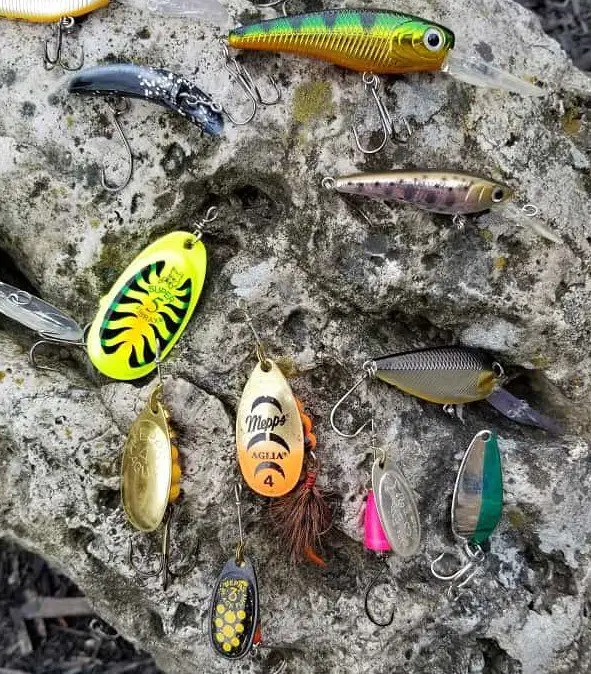
These are the lures you should consider.
- Spinners
- Spoons
- Crankbaits
- Plugs
- Jigs
I discuss my favorites on my page Best Lures For Steelhead: A Pro Guides Recommendations,
Choosing The Right Lure Size and Color
I use lures from two to five inches for steelhead. There are certain situations that require smaller or larger sizes.
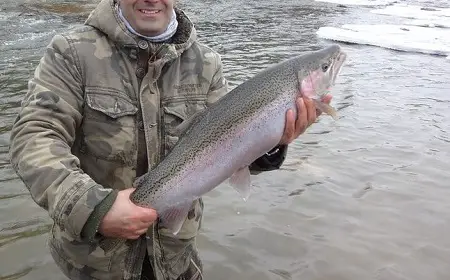
I change my lure sizes based on a number of factors. One day, I might catch lots of steelhead on a 3-inch spoon, while the next day, the steelhead won’t touch it.
- Low Clear Water: I will often go with smaller lures, subtle or dark colors, and lures without a heavy rattle or loud vibrations will work better.
- Nervous Steelhead: When steelhead are being pressured or are nervous, I find smaller lures in darker, more natural colors, or baitfish colors, that do not make a lot of noise, are often best.
- Green Color, Medium Depth, and Speed: When fishing water that is not clear or when the river is deeper and faster, medium to larger lures tend to work better. All colors can work, and three to five-inch lures that have a good vibration or a loud rattle work well.
- High Water, Fast Water, Deep Water, Lower River: In the lower river or when the river is dirty, I do well with larger lures, bright colored lures, and lures that make noise due to a rattle or vibration.
- Winter Fishing, Inactive Fish: When the steelhead are lethargic due to cold water, or they are not very aggressive, I have found lures with a slow, enticing wobble are best.
- Active Fish: If I find that the steelhead are very active and agressive, they will hit just about any lure you throw at them. However, when fishing agressive steelhead, medium to large lures are often best.
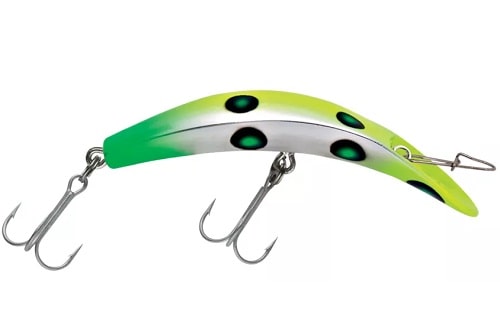
When lure fishing in cold water or slower spots, a slower, erratic-moving lure will often entice more strikes.
Great lures for this are the Kwickfish Xtreme, Flatfish, Or Maglip.
Best Lure Colors
No one color is best! I have my favorite colors for certain conditions, but I will often rotate through colors to find out if one color is going to work better. Bright oranges, Greens, yellows, chartreuse, blacks, or olive greens can all be good choices.
Without a doubt, silver, gold, and copper are my most effective colors. Add some color to them for more contrast, and they can be fantastic.
Lure Size For The River
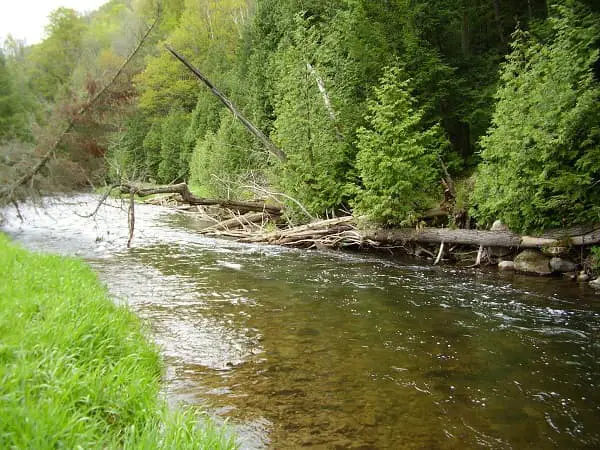
Regardless of the size of the river or the conditions. It makes sense to have plenty of lure types, sizes, and colors, and then rotate through lures if they are not biting what you are using.
- Small Stream Fishing: I tend to use smaller, lighter lures in smaller streams; I also tend to use lure colors that closely imitate the natural baitfish, which means natural or darker colors, unless the water is colored or dirty.
- Medium-Sized Rivers: All lures, all sizes, and all colors will work in mid-sized rivers.
- Large Rivers: I do well with larger and brighter lures in larger rivers.
Lures In Small Streams
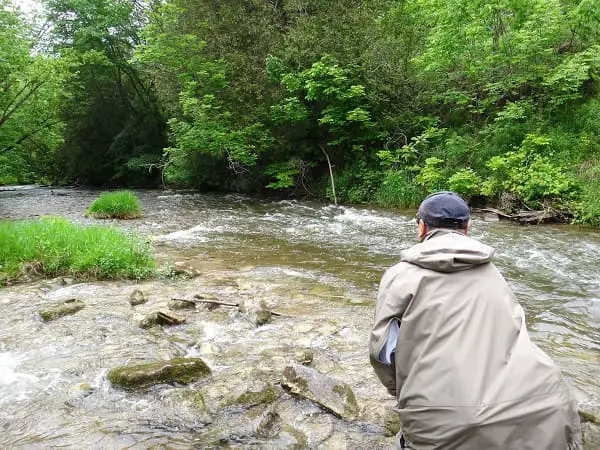
When fishing in smaller streams that are 10 to 25 feet wide and not very deep. I change my tactics, which enables my clients to catch more steelhead.
- Stealth: One thing I do that significantly increases the amount of steelhead I and my clients catch is not to be seen or heard. To do this well, I keep a lower profile, I walk light-footed and walk slower, I fish from below the fish if possible, or when fishing up river, I will stand as far back as possible because fish in a river look upriver and will see you.
- Use Lighter Lures: In smaller clear streams, a large splash from a large heavy lure can spook the steelhead. Lighter lures land softer and won’t spook fish.
- Hit The Bank: When fishing with lures in small creeks, I try to land my lures as close to the far bank as possible. Doing so prevents a mid-pool splash that can spook fish, and it allows the fish to see the lure swim into view and then away from them, which can often trigger more bites.
- Stay Out Of The Water: If you do not need to put your feet into the water, don’t. Steelhead are more likely to detect your presence if you walk in the water.
- Move A Lot: In smaller spots, I tend to spread each and every cast out by 3 to 5 feet starting at the top or back of the spot, especially if the water is clear. This is because Steelhead will be very aware of a lure in a small pool.
- Don’t Cast Twice: I NEVER cast twice in the same spot when fishing small streams, especially with the same lure. In my experience, if the steelhead wants a lure, they will hit it the first time. Casting twice in the same spot is just wasting time. If they do not hit a lure, cast 3 to five feet down and keep going.
- Start Small: In smaller water, I tend to start with smaller lures, and if that does not work, I will start changing lure sizes, colors, and types.
- Slow It Down: Slower lures give the steelhead more time to notice the lures, chase them, and grab them before the lure is too shallow again.
Lure Fishing In Larger Steelhead Rivers
Lure fishing in larger, deeper rivers requires different tactics. You can be less stealthy, you can wade in, you can make multiple casts, and you can fish faster.
- Cover The Water Well: One of the most important things I do when fishing after water is to cover the water thoroughly. When fishing larger rivers, I start at the top of the spot, I cast straight out and as far across as possible, and each cast is 3 to 5 feet downriver from the last cast. I will discuss this more below.
- Get Deep: On larger rivers, the river is often deeper, which means you need to use deeper diving lures, or you need to let the lure sink first to get the lure 2 to 6 feet over the river bottom. This is critical.
- Swing it: Do not reel too fast. Instead, use a slow retrieve and let the lure swing across the current in front of the steelhead.
- Fish Twice: A tactic I have used a lot, and one that works very well for me, is to fish a spot with one type of lure, and then return to the top of the spot and fish it again with a different type of lure.
- Twitch It: Straight, steady retrieves work, but I have found that ripping and twitching a lure every five to 10 feet can trigger a lot more bites.
Pro Tip: I mentioned earlier that when I first started steelhead fishing, I was always excited to see big steelhead follow my lure to the bank, but then they would turn away at the last minute. Many of these steelhead I never saw again.
I spent a lot of time trying to figure out how to get these fish to bite.
I found that when the lure gets five to ten feet off the tip of my rod, and just before it gets too shallow, I will rip-twitch my lure in a way that turns the lure broadside to the steelhead, and then pause it there for three to five seconds. This has resulted in converting a lot of the steelhead that would follow into biters.
Cover The Water Well
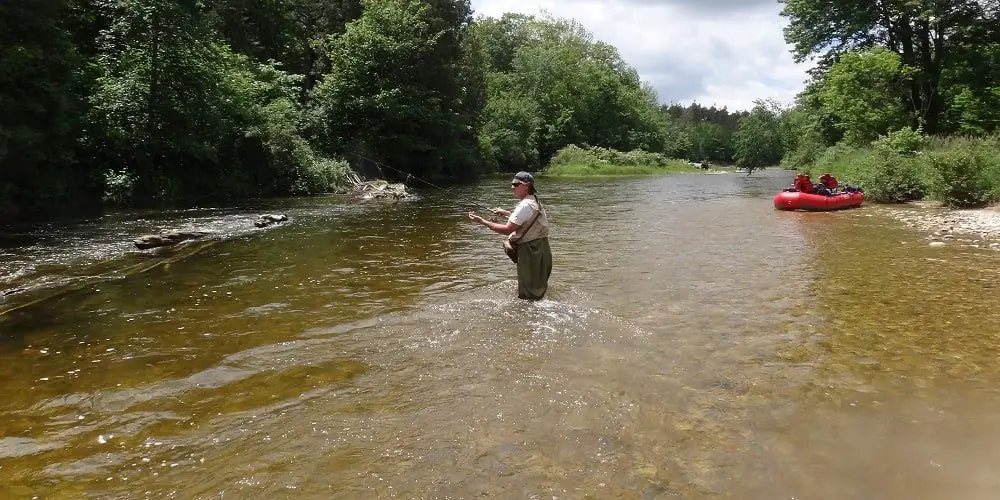
I’ve had the pleasure of guiding and fishing with thousands of anglers. Doing so has taught me a lot. I’ve been able to see how other anglers fish. Sometimes it’s good, but often, when it comes to lure fishing, most guys cover the water poorly.
Most guys cast everywhere and anywhere, and in my opinion, this results in fewer steelhead hooks!
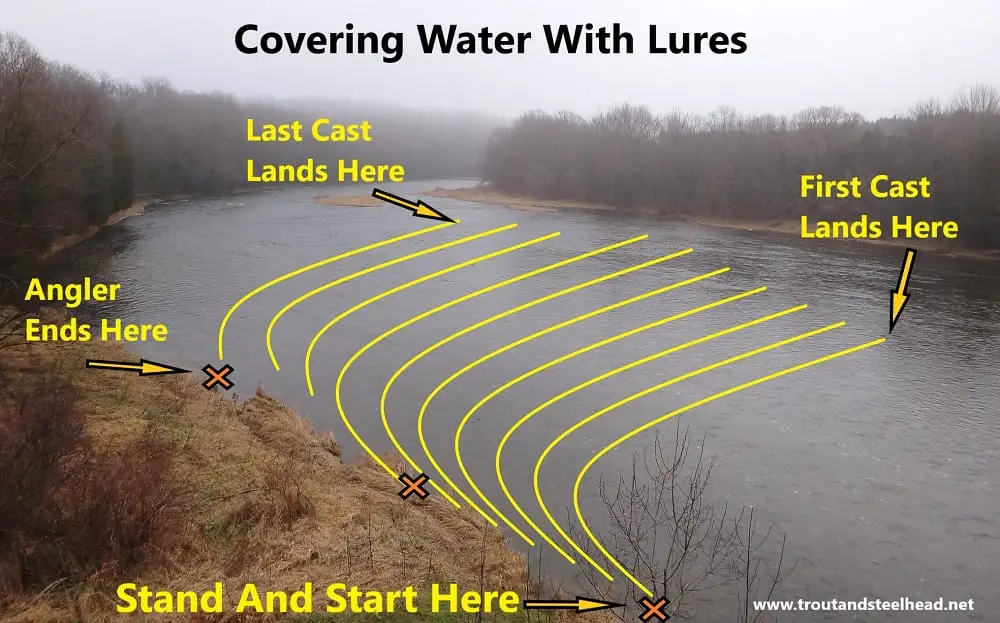
I am very systematic when I fish lures, and I do so to make sure my lure is presented at the right angle, the right speed, and the right depth.
I ensure that every single spot within the spot is covered by my lure and that every fish in the pool sees my lure.
Casting all over without rhyme or reason means many anglers miss fish.
Each cast I make should land about 3 to 6 feet apart starting from the top of the run to the bottom, and the lure is swung across the river at the right depth. If the water is clear, each consecutive cast landed 5 to 6 feet apart. If the water is off-colored or dirty, I may cast every 3 to 4 feet.
Get Deep With Your Lures
Different lures run at different depths. Regardless of the lure you use, you need to make sure that the lure is in the steelhead strike zone and preferably over their heads.
In clear water, 3 to 6 feet over their heads is good. In dirtier water, you may need to six inches over their heads.
Let Them Sink: For sinking lures like spinner and spoons, you may need to let the lure sink to the bottom before you start retrieving the lures.
For deep-diving crankbaits, you can start reeling right away.
Use Your Rod Tip: Keeping your rod tip high will keep the lure higher. Dropping the rod tips close to or even below the water surface will keep the lure deep.
If you are not sure how deep your lures run, start with a high rod tip and pay attention to feel the lure bumping bottom. If you do not bump bottom, keep dropping your rod tip until you hit bottom or hit fish.
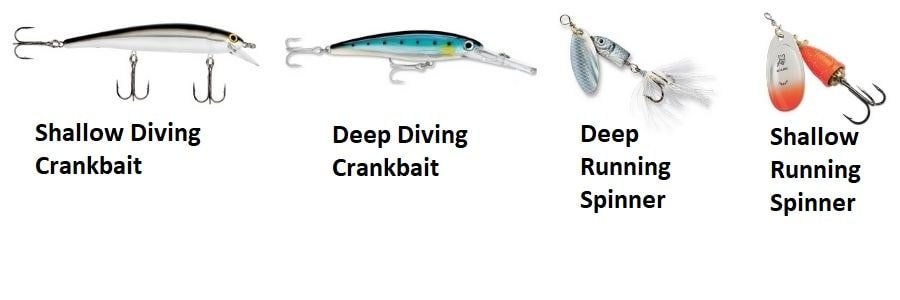
Once you bump and detect the bottom, lift your rod tip two to three feet on each consecutive cast.
Deep And Shallow Lures: Keep in mind that a faster retrieve tends to raise the lure, while a slower steady retrieve will often keep the lure down. Every lure is different, which is why I have lures that will run shallow and some that will run deep.
Stay Off The Bottom: Lures that are run below the fish get hit less. Fish prefer to feed up. Lures on the bottom also get snagged a lot more so keep your lure off the bottom as much as possible.
See the best spinners and spoons at:
Best Lines For Casting Lures
Be sure that you use the right line suitable for both lures and for the size of many steelhead. Your options are Monofilament, fluorocarbon, and Braid.
I mostly use and prefer braided lines combined with a three-foot fluorocarbon leader.
Multipurpose Line
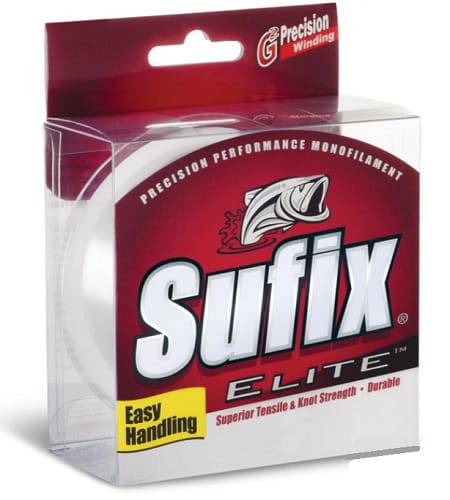
Monofilament line around ten to fourteen pounds are very common and are good for most new anglers.
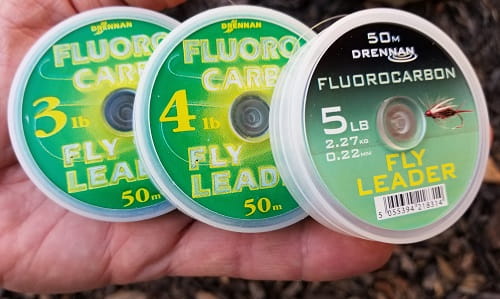
When casting lures with a braided line, I use a 12 to 17-pound fluorocarbon leader attached with a quality 2-way swivel like the SPRO Power Swivels.
If you are going to float fish, use my float fishing leader setup.
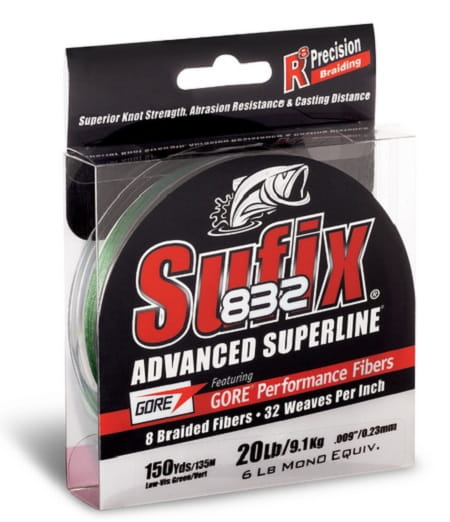
Braid is the best line for lure anglers because it is thin, strong, and has low stretch.
Thin lines cut through the water better so you can get more depth with your lure, and no stretch means more sensitivity to detect the bottom or bite.
Low stretch is also good for better hook sets. 20 to 30-pound braid is good for most steelhead fishing.
Some anglers like to use fluorocarbon mainline on their reels. Fluorocarbon is nearly invisible under the water and is abrasion-resistant. Both are good things with fishing steelhead in rivers. Just be sure you get a good quality fluorocarbon line since cheap ones have all kinds of problems.
Attaching The Lure
There are times I will tie my fluorocarbon leader directly to the lures. I do this with crankbaits a lot.
However, a good black snap swivel is recommend for most lures, especially spinning lures like a spinner that can twist up your line.
Don’t Forget Your Steelhead River Gear
Make sure you have a good rod and reel suitable for casting lures to steelhead.
Rod: 7’6 to 9-foot medium to medium heavy is best. For larger river go with a heavier rod, for small streams, a smaller shorter rod will do.
Reel: Most spinning of baitcasting reel will do. Ensure your reel has a good smooth drag and can hold enough line. A pinning reel in the 3500 to 4500 size is good.
For a full list of gear for river fishing that I use and recommend, check out my page on The Best River Gear.
Tight Lines
Graham
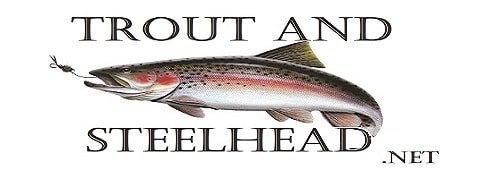
Hey Graham.
Under what conditions should I use a Black spoon?
Ward.
Hi Russel,
A black spoon or lure can imitate leeches or darker-colored baitfish like sculpins so they can work anytime. There have been times when they won’t touch bright-colored lures or shiny lures in gin-clear water, but they will hit black or a dark lure.
Also, despite what most anglers would think or the opposite of what most anglers think, I have learned that often my most productive lure in the dark is solid black. They seem to pick up that dark silhouette better than lighter colors. I’ve also found that noisy black lures are even better in the dark.
Good Luck,
Graham
Great article. Thanks. I love this the best. Fishing hardware for trout and Salmon, in my opinion, is second to none. Greetings from Linwood Michigan.